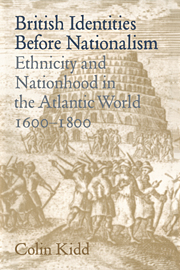2 - Prologue: the Mosaic foundations of early modern European identity
Published online by Cambridge University Press: 06 July 2009
Summary
Historians appreciate that early modern nationhood was inextricably bound up with confessional identity. By contrast, however, the parallel connection between theology and ethnicity has largely escaped the attention of mainstream historiography. Yet this was a profound relationship whose central importance within the realm of Christian apologetic has long been recognised by students of historical theology. For the peopling of the world was a familiar part of sacred history and a topic which occupied a crucial place in the Bible. The first five verses of Genesis 10 constituted the fundamental text which associated the peopling of Europe with the Japhetan descendants of Noah, and described the basic relationships of the various tributaries of the Japhetan lineage:
Now these are the generations of the sons of Noah, Shem, Ham and Japheth; and unto them were born after the flood. The sons of Japheth: Gomer and Magog, and Madai, and Javan, and Tubal, and Meshech, and Tiras. And the sons of Gomer; Ashkenaz, and Riphath, and Togarmah. And the sons of Javan; Elishah and Tarshish, Kittim and Dodanim. By these were the isles of the Gentiles divided in their lands; every one after his tongue, after their families, in their nations.
A few other passages of Scripture also dealt with ethnological matters: the story of the confounding of languages at the Tower of Babel in chapter 11 of Genesis, and some later references to the descendants of Noah in chapter 38 of Ezekiel.
- Type
- Chapter
- Information
- British Identities before NationalismEthnicity and Nationhood in the Atlantic World, 1600–1800, pp. 9 - 33Publisher: Cambridge University PressPrint publication year: 1999
- 1
- Cited by



